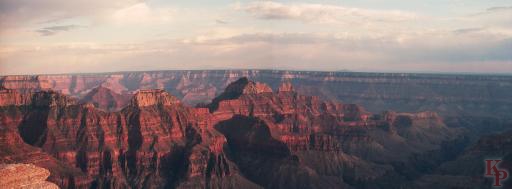
Arizona, the state that fought for years to prevent Grand Canyon becoming a National Park, recognized the tremendous impact of Grand Canyon on the economy. Now it is on the license plate and almost the only reason to visit Arizona in the summer.
A lot of places claim to be the Grand Canyon of something-or-the-other, but there is only one Grand Canyon. Grand Canyon is timeless, yet provides a record of time; changeless, yet is different by the hour. Other canyons may be longer, deeper, wider, steeper, but none have all the qualities that make this canyon Grand.
Most people visit Grand Canyon on a longer trip (e.g. heading to California), others travel long distances just for the visit to the canyon (e.g. from Europe). Either way, about 4 million people visit every year (the second most for a US National Park, but unlike the Great Smoky Mountains (the most visited National Park) you have to detour to the park, and it is a longer trip to get there) and if you are there on a summer day it seems all 4 million visitors are there that day.
|
|
The documentary
Ken Burns: National Parks - America's Best Idea
is a must-see. Grand Canyon and some of the difficulty in creating the park
are covered. Including Roosevelt's use of the Antiquities Act originally
intended for small sites to establish the original monument.
East from the junction of the route south to Williams (and Flagstaff) past Mather Point, Desert View Drive leaves most of the crowds behind and has some of the best views. Yaki Point (shuttle only), Grandview Point, Moran Point, Lipan Point, Navajo Point and Desert View. Along the eastern drive, you see outstanding views without the crowding.
Most of the accomodations (lodges, campgrounds, store, staff housing, some parking , hospital, train station) are in the area called Grand Canyon Village. This area also covers some of the most famous views. The new visitor center area (including Mather Point) is the primary shuttle station and parking area. Shuttles are free and sometimes can be crowded. Using the shuttle is necessary for visiting parts of the rim, but, from the statistics available, shuttle boardings are only slightly higher than total visitors. (And many shuttle users board a shuttle multiple times on one visit.) The new parking at the visitor center can fill up, but it is better than the parking in the Village area. Often vacant parking spaces are available at the Headquarters (Shrine of the Ages) shuttle stop and near the Backcountry office (also a shuttle stop), but parking anywhere can be difficult in the peak summer periods.
Is it a drive if you have to ride the shuttle? The viewpoints on the West Rim Drive have very little parking and require using the shuttle much of the year (you can bike or walk any time with no limits, except bikes are allowed only on pavement and walk on the marked trails). Proper visits to the West Rim Drive area require a more leisurely pace and the shuttle system simplifies walking between adjacent views. You can escape the crowded bus and especially the crowds around the lodges by taking selected walks. A note on crowds on the shuttle: At the ends (the transfer near the Bright Angel Trail and Hermit's Rest) drivers only take on passengers until the bus seats are filled (no standing). This allows people to board at the first stop where standees are allowed. If you are using the shuttle for some parts and walking others, it may be best to walk the first part on each end. Also, crowds are much less before the train arrives and before people driving in arrive for the day.

In the summer, the North Rim is the uncrowded alternative for visits. It is also less accessible to most visitors due to the long drive from Interstate 40. Views are different, sun angles are different. The North Rim is less rushed and more enjoyable, but covered in deep snow all winter.
Nestled among the cottonwoods along Bright Angel Creek is the Phantom Ranch Lodge, Campground, and Ranger Station. It is a small town with mail delivery via mule. You get there either by walking or by mule, and reservations are required.
The first thing you learn when hiking in Grand Canyon is that, contrary to what you originally think, going up is easier than going down. Back country here is very different from other parks since you are often within sight of populated areas (but it can still be impossible to get there). All travel below the rim depends on water. Either where it is for drinking or how much there is for rafting. Almost all the trail traffic is on the 3 trails that meet at Phantom Ranch -- Bright Angel, North Kaibab, and South Kaibab.
Today it is hard to believe, but the establishment of Grand Canyon National Park was not easy. Legislation failed in 1882 (10 years after Yellowstone was created), and again in 1883 and 1886. Harrison (the sponsor in 1886) created the Grand Canyon Forest Reserve in 1893 when he was president (Presidential Proclamation #45). Theodore Roosevelt created the Game Reserve and then the National Monument in 1908 (Presidential Proclamation #794). Attempts to designate the park failed again in 1910 and 1911 (before Arizona became a state), but were finally successful in February 1919. The National Park was expanded in 1975.
The Official Grand Canyon National Park site has all the offical information, including the pointers to accomodations, camping, hiking, news, traffic, weather, shuttles, etc. Why look anywhere else when this is the current information.
The Grand Canyon Webcam may be of interest.
Maintained by Keith Price.